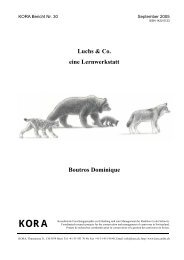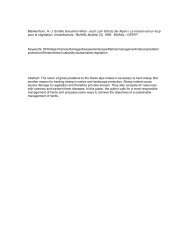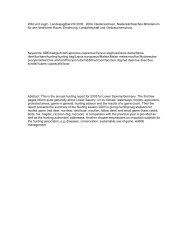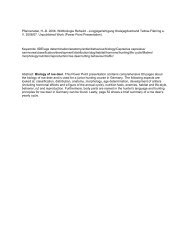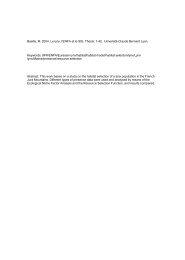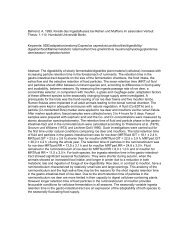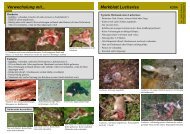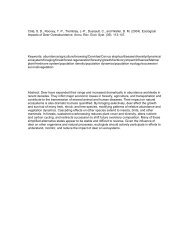Create successful ePaper yourself
Turn your PDF publications into a flip-book with our unique Google optimized e-Paper software.
30 Appendix IKORA <strong>Bericht</strong> Nr. 13ReferencesBreitenmoser, U. and Ch. Breitenmoser-Würsten, 1990.Status, conservation needs and reintroduction of the lynxLynx lynx in Europe. Nature and environment Series, No.45. Strasbourg: Council of Europe.Caro, T. M. and S. M. Durant, 1991. Use of quantitativeanalyses of pelage characteristics to reveal family resemblancesin genetically monomorphic cheetahs. Journal ofHeredity 82: 8–14.Eizirik, E. Pers. Comm. Laboratory of Genomic Diversity,National Cancer Institute, Frederickton, USA.Endler, J. A. 1978. A predator’s view of animal colour patterns.Evol. Biol. 11: 319–364.Endler, J. A. 1988. Frequency-dependent predation, crypsisand aposematic colouration. Proc. Trans. Roy. Soc. London.(ser. B) 319: 505–523.Garcia-Perea, R. 1994. The Pampas Cat Group (genus LynchailurusSevertzov, 1858) (Carnivora: Felidae), a systematicand biogeographic review. American Museum ofNatural History Nr 3096: 1–35 (New York).Garcia-Perea, R. 1994. Pampas Cats: how many species?.Cat News 20: 21–24.odfrey, D., J. N. Lythgoe and D. A. Rumball, 1987. Zebrastripes and tiger stripes: the spatial frequency distributionof the pattern compared to that of the background is significantin display and crypsis. Biological Journal of theLinnean Society 32: 427–433.Karanth, K. U. 1995. Estimating tiger populations from camera-trapdata using capture-recapture models. Biologicalconservation 71: 333–338.Karanth, U. and J. D. Nichols, 1998. Estimation of Tigerdensities in India using photographic captures and Recaptures.Ecology 79 (8): 2852–2862.Laass, J. 1999. Evaluation von Photofallen für ein quantitativesMonitoring einer Luchspopulation in den Alpen. Diplomarbeit,BOKU Wien, 75 pp.Matjuschkin, E. N. 1978. Der Luchs. A. Ziemsen Verlag,Wittenberg Lutherstadt, Germany, 160 pp.Miric, D. J. 1978. Die Luchspopulationen der Balkanhalbinsel.Serbian Academy of Sciences and Arts, Vol.DXXXIX, (55): 150 pp.Murray, J.D. 1981b. A pre-pattern formation mechanism foranimal coat markings. Journal of Theoret. Biol. 88: 161–199.Murray, J.D. 1988. How the Leopard gets its spots. Scientific.American 3/1988:62–69.Nowell K. and P. Jackson 1996. Wild Cats. InternationalUnion for Conservation of Nature and Natural Resources,110 pp.Ognev, S. L. 1935. Mammals of USSR and adjacent countries.Vol. 3: 165–186, Carnivora, Moscow.Ortolani, A. and T. Caro, 1996. The Adaptive Significanceof Colour Patterns in Carnivores: Phylogenetic Tests ofClassic Hypotheses. In: Gittleman J. L. (ed.) CarnivoreBehavior, Ecology, and Evolution, Vol. 2: 132–188.Ithaca, Cornell University Press.Ragni, B., M. Possenti and S. Mayr, 1993. The Lynx in theItalian Alps. Cat News 19: 21–25.Robinson, R. 1977. Genetics for Cat Breeders. PergamonPress. London.Robinson, R. 1978. Homologous coat colour variation inFelids. Carnivore 1: 68–71.Schaller, G. B. 1967. The deer and the tiger. University ofChicago Press. Chicago. Illinois. USA.Stollmann, A. 1963. Beitrag zur Kenntnis des Luchses, Lynxlynx in den tschechoslowakischen Karpaten. Folia Zoologica,Brünn (Brno), 12: 301–316.Turing, A. M. 1952. Phil. Trans. Roy. Soc. London. B. 237,37.Vasiliu, G. D. and P. Decei, 1964. Über den Luchs (Lynxlynx) der rumänischen Karpaten. Säugetierkundliche Mitteilungen,München, 12: 155–183. (Bukarest).Weigel, I. 1961. Das Fellmuster der wildlebenden Katzenartenund der Hauskatze in vergleichender und stammesgeschichtlicherHinsicht. Säugetierkundliche Mitteilungen,München, 120 pp.Werdelin, L. and L. Olsson, 1997. How the Leopard got itsspots: a phylogenetic view of the evolution of felid coatpatterns. Biological Journal of the Linnean Society 62:383–400.



